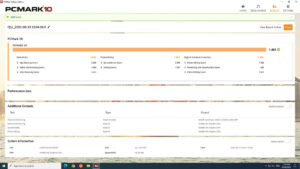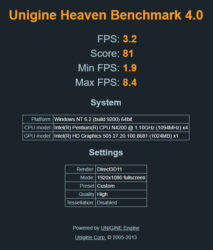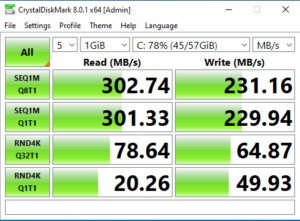备注:ECS,Elitegroup Computer Systems即精英公司的英文缩写。ECS是著名的计算机硬件厂商,成立于1987年。该公司的主要产品有台式多媒体产品、笔记本电脑和计算机主板等。另外,ECS也是电气控制系统的英文缩写。

ECS公司(精英公司)有一系列名为 LIVA 的迷你 PC,其中就包括之前我评测过的 LIVA Q2小型 Q 系列。不过,这一次终于轮到 LIVA Q1L 了,虽然它已经是一年前发布的了,但我最近才得到他,并进行了一些评测,具体的测试结果如下。
硬件概览
Q1L 外观上是由一个 74 x 74 x 34.6 mm(2.91 x 2.91 x 1.36 英寸)的矩形塑料外壳组成的。它是一款主动散热型迷你 PC,配置的是稍微老式一点的 Apollo Lake 处理器。我评测的这一款配备的型号是 N4200 CPU,这是一款四核 4 线程 1.10 GHz 处理器,最大单核频率2.50GHz,同时配备了英特尔 HD Graphics 505核芯显卡。
它的正面有一个电源按钮、两个 USB 3.2 Gen 1×1 端口和一个 USB 2.0 端口,而背面则包括一个 HDMI 端口、两个千兆以太网端口和电源插孔。左侧是一个micro- SD 卡插槽,右侧是一个 Kensington 安全插槽。
评测模型还包括单通道4 GB 焊接式 LPDDR4 2400 Mhz 内存和 64 GB 的焊接 eMMC。

此外,还有一个焊接的 Qualcomm Atheros QCA6174 WiFi 5(或 802.11ac)模块。
该设备的内部由两个堆叠的主板组成,底部的主板包含所有 I/O 端口和顶部的一个风扇。

包装清单
在包装盒中,你会得到一个电源适配器和电源线、一个适合你所在国家/地区的单独插头适配器、一个 VESA 安装支架以及用于将设备连接到显示器后面的螺钉。
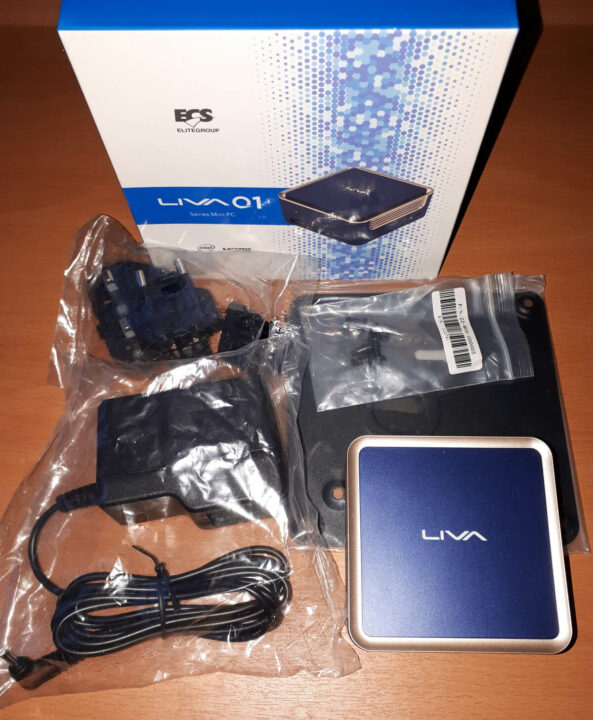
ECS 网站上也给用户提供了使用手册。
评测方法
在评测迷你 PC 时,我通常会同时查看它们在 Windows 和 Linux (Ubuntu) 下的性能,并将它们与一些最近发布的迷你 PC 进行比较。其实,自 2021 年初以来,我就一直在使用 Windows 10 版本 21H1 和 Ubuntu 20.04 LTS 进行审核,但是由于评测单元不包括 Windows 的许可副本,所以我就使用了 Windows 10 企业评估版 21H1。同时,我也进行了一系列常用的 Windows 基准测试和 Linux 的等效测试,以及 Thomas Kaiser 的“sbc-bench”,这其实是在一个组里进行的不同 CPU 性能测试,主要专注在 Ubuntu 上运行时的服务器性能。我还在 Windows 和 Ubuntu 上使用了“Phoronix 测试套件”和基准测试,通过这些测试进行一个比较。在 Ubuntu 上,我也使用了默认设置编译Linux kernel内核的v5.4来测试其在真实场景下的性能。
在进行基准测试之前,我执行所有必要的安装和更新从而方便运行两个操作系统的最新版本。我还为每个操作系统记录了设备的一些基本细节。
Windows性能
实际上,Q1L 的零售版本是随产品附带有 Windows 10 专业版许可副本的,但我收到的样本却只装有测试用的Windows 版本,因此我又进行了 Windows 10 企业评估版 21H1 的全新安装。升级到build 19043.1165后,查看硬件信息,信息显示如下:



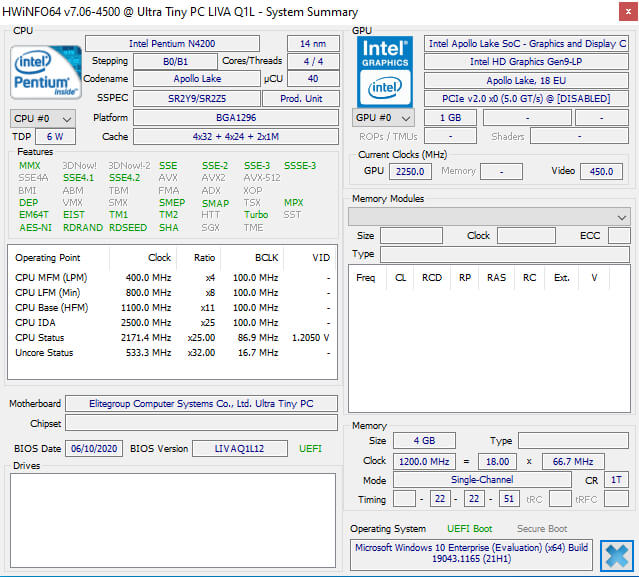
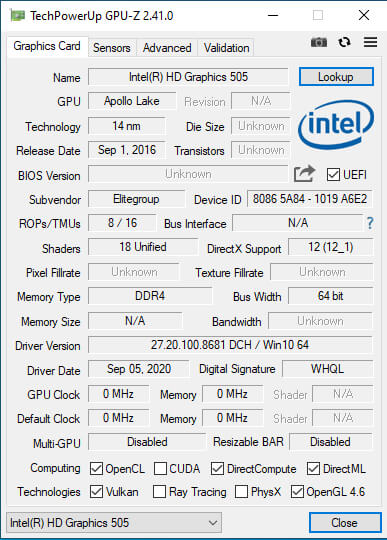
我简单检查了显示 HDMI 音频、micro-SD、Wi-Fi、蓝牙和以太网,一切都是正常工作的。
然后,我将电源模式设置为“顶级性能模式”并运行了我的 (2021) 标准基准测试工具集来查看 Windows 下的性能。
对于我特意设置的一组 Phoronix 测试套件测试,结果如下:

然后我又将所有这些结果与市面上其他最新的迷你 PC 进行了比较:

对比结果表明虽然这不是一个非常强大的处理器,且考虑到到使用单通道内存运行造成的限制,其结果与使用相同的旧Pentium N4200 CPU的其他迷你 PC 一致,
LIVA Q1L Ubuntu 性能
由于 eMMC 在安装 Windows 和基准测试软件后剩余的可用空间有限,因此我使用 Ubuntu 20.04.2.0 ISO 执行了 Ubuntu 的全新安装。安装和更新后,简要检查显示 HDMI 音频、微型 SD、Wi-Fi、蓝牙和以太网。
Ubuntu 20.04.2下关键硬件信息如下:


|
1 2 3 4 5 6 7 8 9 10 11 12 13 14 15 16 17 18 19 20 21 22 23 24 25 26 27 28 29 30 31 32 33 34 35 36 37 38 39 40 41 42 43 44 45 46 47 48 49 50 51 52 53 54 55 56 57 58 59 60 61 62 63 64 65 66 67 68 69 70 71 72 73 74 75 76 77 78 79 80 81 82 83 84 85 86 87 88 89 90 91 92 93 94 95 96 97 98 99 100 101 102 103 104 105 106 107 108 109 110 111 112 113 114 115 116 117 118 119 120 121 122 123 124 125 126 127 128 129 130 131 132 133 134 135 136 137 138 139 140 141 142 143 144 145 146 147 148 149 150 151 152 153 154 155 156 157 158 159 160 161 162 163 164 165 166 167 168 169 170 171 172 173 174 175 176 177 178 179 180 181 182 183 184 185 186 187 188 189 190 191 192 193 194 195 196 197 198 199 200 201 202 203 204 205 206 207 208 209 210 211 212 213 214 215 216 217 218 219 220 221 222 223 224 225 226 227 228 229 230 231 232 233 234 235 |
linuxium@Q1L:~$ lsb_release -a Distributor ID: Ubuntu Description: Ubuntu 20.04.2 LTS Release: 20.04 Codename: focal linuxium@Q1L:~$ linuxium@Q1L:~$ uname -a Linux Q1L 5.11.0-25-generic #27~20.04.1-Ubuntu SMP Tue Jul 13 17:41:23 UTC 2021 x86_64 x86_64 x86_64 GNU/Linux linuxium@Q1L:~$ linuxium@Q1L:~$ inxi -Fc0 System: Host: Q1L Kernel: 5.11.0-25-generic x86_64 bits: 64 Desktop: Gnome 3.36.9 Distro: Ubuntu 20.04.2 LTS (Focal Fossa) Machine: Type: Mini-pc System: Ultra Tiny PC product: LIVA Q1L v: 1.0 serial: XXXXXXXXXXXXXXX Mobo: Elite Systems model: Ultra Tiny PC serial: XXXXXXXXXXXXXXX UEFI: American Megatrends v: LIVAQ1L12 date: 06/10/2020 CPU: Topology: Quad Core model: Intel Pentium N4200 bits: 64 type: MCP L2 cache: 1024 KiB Speed: 2388 MHz min/max: 800/2500 MHz Core speeds (MHz): 1: 2316 2: 2388 3: 2481 4: 2409 Graphics: Device-1: Intel Celeron N3350/Pentium N4200/Atom E3900 Series Integrated Graphics driver: i915 v: kernel Display: server: X.Org 1.20.11 driver: i915 resolution: 1920x1080~60Hz OpenGL: renderer: Mesa Intel HD Graphics 505 (APL 3) v: 4.6 Mesa 21.0.3 Audio: Device-1: Intel Celeron N3350/Pentium N4200/Atom E3900 Series Audio Cluster driver: snd_hda_intel Sound Server: ALSA v: k5.11.0-25-generic Network: Device-1: Qualcomm Atheros QCA6174 802.11ac Wireless Network Adapter driver: ath10k_pci IF: wlp1s0 state: down mac: xx:xx:xx:xx:xx:xx Device-2: Realtek RTL8111/8168/8411 PCI Express Gigabit Ethernet driver: r8169 IF: enp2s0 state: down mac: xx:xx:xx:xx:xx:xx Device-3: Realtek RTL8111/8168/8411 PCI Express Gigabit Ethernet driver: r8169 Device-4: Qualcomm Atheros type: USB driver: btusb IF-ID-1: eno1 state: up speed: 1000 Mbps duplex: full mac: xx:xx:xx:xx:xx:xx Drives: Local Storage: total: 57.66 GiB used: 19.22 GiB (33.3%) ID-1: /dev/mmcblk1 vendor: BIWIN model: N/A size: 57.66 GiB Partition: ID-1: / size: 56.01 GiB used: 19.22 GiB (34.3%) fs: ext4 dev: /dev/mmcblk1p2 Sensors: System Temperatures: cpu: 48.0 C mobo: N/A Fan Speeds (RPM): N/A Info: Processes: 217 Uptime: 9m Memory: 3.67 GiB used: 797.6 MiB (21.2%) Shell: new-review-test inxi: 3.0.38 linuxium@Q1L:~$ linuxium@Q1L:~$ df -h Filesystem Size Used Avail Use% Mounted on udev 1.9G 0 1.9G 0% /dev tmpfs 376M 1.7M 374M 1% /run /dev/mmcblk1p2 57G 20G 34G 37% / tmpfs 1.9G 0 1.9G 0% /dev/shm tmpfs 5.0M 4.0K 5.0M 1% /run/lock tmpfs 1.9G 0 1.9G 0% /sys/fs/cgroup /dev/loop0 56M 56M 0 100% /snap/core18/1988 /dev/loop1 52M 52M 0 100% /snap/snap-store/518 /dev/loop2 219M 219M 0 100% /snap/gnome-3-34-1804/66 /dev/loop4 32M 32M 0 100% /snap/snapd/11036 /dev/loop3 65M 65M 0 100% /snap/gtk-common-themes/1514 /dev/mmcblk1p1 511M 5.3M 506M 2% /boot/efi tmpfs 376M 28K 376M 1% /run/user/1000 /dev/loop5 56M 56M 0 100% /snap/core18/2128 /dev/loop6 33M 33M 0 100% /snap/snapd/12704 /dev/loop7 51M 51M 0 100% /snap/snap-store/547 /dev/loop8 66M 66M 0 100% /snap/gtk-common-themes/1515 /dev/loop9 219M 219M 0 100% /snap/gnome-3-34-1804/72 linuxium@Q1L:~$ linuxium@Q1L:~$ lsblk -a NAME MAJ:MIN RM SIZE RO TYPE MOUNTPOINT loop0 7:0 0 55.5M 1 loop /snap/core18/1988 loop1 7:1 0 51M 1 loop /snap/snap-store/518 loop2 7:2 0 219M 1 loop /snap/gnome-3-34-1804/66 loop3 7:3 0 64.8M 1 loop /snap/gtk-common-themes/1514 loop4 7:4 0 31.1M 1 loop /snap/snapd/11036 loop5 7:5 0 55.4M 1 loop /snap/core18/2128 loop6 7:6 0 32.3M 1 loop /snap/snapd/12704 loop7 7:7 0 51M 1 loop /snap/snap-store/547 loop8 7:8 0 65.1M 1 loop /snap/gtk-common-themes/1515 loop9 7:9 0 219M 1 loop /snap/gnome-3-34-1804/72 mmcblk1 179:0 0 57.7G 0 disk ├─mmcblk1p1 179:1 0 512M 0 part /boot/efi └─mmcblk1p2 179:2 0 57.2G 0 part / mmcblk1boot0 179:8 0 4M 1 disk mmcblk1boot1 179:16 0 4M 1 disk linuxium@Q1L:~$ linuxium@Q1L:~$ sudo lshw -C cpu *-cpu description: CPU product: Intel(R) Pentium(R) CPU N4200 @ 1.10GHz vendor: Intel Corp. physical id: 2c bus info: cpu@0 version: Intel(R) Pentium(R) CPU N4200 @ 1.10GHz slot: SOCKET 0 size: 2405MHz capacity: 2500MHz width: 64 bits clock: 100MHz capabilities: lm fpu fpu_exception wp vme de pse tsc msr pae mce cx8 apic sep mtrr pge mca cmov pat pse36 clflush dts acpi mmx fxsr sse sse2 ss ht tm pbe syscall nx pdpe1gb rdtscp x86-64 constant_tsc art arch_perfmon pebs bts rep_good nopl xtopology tsc_reliable nonstop_tsc cpuid aperfmperf tsc_known_freq pni pclmulqdq dtes64 monitor ds_cpl vmx est tm2 ssse3 sdbg cx16 xtpr pdcm sse4_1 sse4_2 x2apic movbe popcnt tsc_deadline_timer aes xsave rdrand lahf_lm 3dnowprefetch cpuid_fault cat_l2 ibrs ibpb stibp tpr_shadow vnmi flexpriority ept vpid ept_ad fsgsbase tsc_adjust smep erms mpx rdt_a rdseed smap clflushopt intel_pt sha_ni xsaveopt xsavec xgetbv1 xsaves dtherm ida arat pln pts md_clear arch_capabilities cpufreq configuration: cores=4 enabledcores=4 threads=4 linuxium@Q1L:~$ linuxium@Q1L:~$ sudo lshw -C memory *-firmware description: BIOS vendor: American Megatrends Inc. physical id: 0 version: LIVAQ1L12 date: 06/10/2020 size: 64KiB capacity: 6MiB capabilities: pci upgrade shadowing cdboot bootselect socketedrom edd int13floppy1200 int13floppy720 int13floppy2880 int5printscreen int14serial int17printer acpi usb biosbootspecification uefi *-memory description: System Memory physical id: 26 slot: System board or motherboard size: 4GiB *-bank:0 description: DIMM LPDDR4 Synchronous 2400 MHz (0.4 ns) vendor: Unde physical id: 0 serial: XXXXXXXX slot: ChannelA-DIMM0 size: 2GiB width: 16 bits clock: 2400MHz (0.4ns) *-bank:1 description: DIMM LPDDR4 Synchronous 2400 MHz (0.4 ns) vendor: Unde physical id: 1 serial: XXXXXXXX slot: ChannelB-DIMM0 size: 2GiB width: 16 bits clock: 2400MHz (0.4ns) *-cache:0 description: L1 cache physical id: 2a slot: CPU Internal L1 size: 224KiB capacity: 224KiB capabilities: synchronous internal write-back configuration: level=1 *-cache:1 description: L2 cache physical id: 2b slot: CPU Internal L2 size: 2MiB capacity: 2MiB capabilities: synchronous internal write-back unified configuration: level=2 linuxium@Q1L:~$ linuxium@Q1L:~$ free -mh total used free shared buff/cache available Mem: 3.7Gi 669Mi 421Mi 181Mi 2.6Gi 2.6Gi Swap: 2.0Gi 0B 2.0Gi linuxium@Q1L:~$ linuxium@Q1L:~$ sudo lshw -C network *-network description: Wireless interface product: QCA6174 802.11ac Wireless Network Adapter vendor: Qualcomm Atheros physical id: 0 bus info: pci@0000:01:00.0 logical name: wlp1s0 version: 32 serial: xx:xx:xx:xx:xx:xx width: 64 bits clock: 33MHz capabilities: pm msi pciexpress bus_master cap_list ethernet physical wireless configuration: broadcast=yes driver=ath10k_pci driverversion=5.11.0-25-generic firmware=WLAN.RM.4.4.1-00140-QCARMSWPZ-1 latency=0 link=no multicast=yes wireless=IEEE 802.11 resources: irq:131 memory:91000000-911fffff *-network description: Ethernet interface product: RTL8111/8168/8411 PCI Express Gigabit Ethernet Controller vendor: Realtek Semiconductor Co., Ltd. physical id: 0 bus info: pci@0000:02:00.0 logical name: enp2s0 version: 15 serial: xx:xx:xx:xx:xx:xx capacity: 1Gbit/s width: 64 bits clock: 33MHz capabilities: pm msi pciexpress msix bus_master cap_list ethernet physical tp mii 10bt 10bt-fd 100bt 100bt-fd 1000bt-fd autonegotiation configuration: autonegotiation=on broadcast=yes driver=r8169 driverversion=5.11.0-25-generic firmware=rtl8168h-2_0.0.2 02/26/15 latency=0 link=no multicast=yes port=twisted pair resources: irq:23 ioport:e000(size=256) memory:91404000-91404fff memory:91400000-91403fff *-network description: Ethernet interface product: RTL8111/8168/8411 PCI Express Gigabit Ethernet Controller vendor: Realtek Semiconductor Co., Ltd. physical id: 0 bus info: pci@0000:03:00.0 logical name: eno1 version: 15 serial: xx:xx:xx:xx:xx:xx size: 1Gbit/s capacity: 1Gbit/s width: 64 bits clock: 33MHz capabilities: pm msi pciexpress msix bus_master cap_list ethernet physical tp mii 10bt 10bt-fd 100bt 100bt-fd 1000bt-fd autonegotiation configuration: autonegotiation=on broadcast=yes driver=r8169 driverversion=5.11.0-25-generic duplex=full firmware=rtl8168h-2_0.0.2 02/26/15 ip=xxx.xxx.xxx.xxx latency=0 link=yes multicast=yes port=twisted pair speed=1Gbit/s resources: irq:20 ioport:d000(size=256) memory:91304000-91304fff memory:91300000-91303fff linuxium@Q1L:~$ linuxium@Q1L:~$ sudo lshw -C display *-display description: VGA compatible controller product: Celeron N3350/Pentium N4200/Atom E3900 Series Integrated Graphics Controller vendor: Intel Corporation physical id: 2 bus info: pci@0000:00:02.0 version: 0b width: 64 bits clock: 33MHz capabilities: pciexpress msi pm vga_controller bus_master cap_list rom configuration: driver=i915 latency=0 resources: irq:130 memory:90000000-90ffffff memory:80000000-8fffffff ioport:f000(size=64) memory:c0000-dffff linuxium@Q1L:~$ linuxium@Q1L:~$ dmesg | grep "MMC card" [ 1.454247] mmc1: new HS400 MMC card at address 0001 linuxium@Q1L:~$ linuxium@Q1L:~$ lsusb Bus 002 Device 001: ID 1d6b:0003 Linux Foundation 3.0 root hub Bus 001 Device 004: ID 0cf3:e300 Qualcomm Atheros Communications Bus 001 Device 003: ID 093a:2510 Pixart Imaging, Inc. Optical Mouse Bus 001 Device 002: ID 046d:c31c Logitech, Inc. Keyboard K120 Bus 001 Device 001: ID 1d6b:0002 Linux Foundation 2.0 root hub linuxium@Q1L:~$ linuxium@Q1L:~$ lspci -nn 00:00.0 Host bridge [0600]: Intel Corporation Celeron N3350/Pentium N4200/Atom E3900 Series Host Bridge [8086:5af0] (rev 0b) 00:02.0 VGA compatible controller [0300]: Intel Corporation Celeron N3350/Pentium N4200/Atom E3900 Series Integrated Graphics Controller [8086:5a84] (rev 0b) 00:0e.0 Audio device [0403]: Intel Corporation Celeron N3350/Pentium N4200/Atom E3900 Series Audio Cluster [8086:5a98] (rev 0b) 00:0f.0 Communication controller [0780]: Intel Corporation Celeron N3350/Pentium N4200/Atom E3900 Series Trusted Execution Engine [8086:5a9a] (rev 0b) 00:13.0 PCI bridge [0604]: Intel Corporation Celeron N3350/Pentium N4200/Atom E3900 Series PCI Express Port A #1 [8086:5ad8] (rev fb) 00:13.1 PCI bridge [0604]: Intel Corporation Celeron N3350/Pentium N4200/Atom E3900 Series PCI Express Port A #2 [8086:5ad9] (rev fb) 00:13.2 PCI bridge [0604]: Intel Corporation Celeron N3350/Pentium N4200/Atom E3900 Series PCI Express Port A #3 [8086:5ada] (rev fb) 00:15.0 USB controller [0c03]: Intel Corporation Celeron N3350/Pentium N4200/Atom E3900 Series USB xHCI [8086:5aa8] (rev 0b) 00:16.0 Signal processing controller [1180]: Intel Corporation Celeron N3350/Pentium N4200/Atom E3900 Series I2C Controller #1 [8086:5aac] (rev 0b) 00:1b.0 SD Host controller [0805]: Intel Corporation Celeron N3350/Pentium N4200/Atom E3900 Series SDXC/MMC Host Controller [8086:5aca] (rev 0b) 00:1c.0 SD Host controller [0805]: Intel Corporation Celeron N3350/Pentium N4200/Atom E3900 Series eMMC Controller [8086:5acc] (rev 0b) 00:1e.0 SD Host controller [0805]: Intel Corporation Celeron N3350/Pentium N4200/Atom E3900 Series SDIO Controller [8086:5ad0] (rev 0b) 00:1f.0 ISA bridge [0601]: Intel Corporation Celeron N3350/Pentium N4200/Atom E3900 Series Low Pin Count Interface [8086:5ae8] (rev 0b) 00:1f.1 SMBus [0c05]: Intel Corporation Celeron N3350/Pentium N4200/Atom E3900 Series SMBus Controller [8086:5ad4] (rev 0b) 01:00.0 Network controller [0280]: Qualcomm Atheros QCA6174 802.11ac Wireless Network Adapter [168c:003e] (rev 32) 02:00.0 Ethernet controller [0200]: Realtek Semiconductor Co., Ltd. RTL8111/8168/8411 PCI Express Gigabit Ethernet Controller [10ec:8168] (rev 15) 03:00.0 Ethernet controller [0200]: Realtek Semiconductor Co., Ltd. RTL8111/8168/8411 PCI Express Gigabit Ethernet Controller [10ec:8168] (rev 15) linuxium@Q1L:~$ |
然后我将 CPU 比例调节器设置为“performance”并运行我的 Linux 基准测试,其中大部分结果都是基于文本的,其图形结果如下所示:


接着,我运行Passmark Performance 进行了Linux性能测试。

我把其测试结果直接与在 Windows 中运行的 CPU 测试结果进行了比较:

对于同一组 Phoronix 的测试套件,其测试结果如下:

我又将完整的结果与其他最近新发布的一些迷你 PC 进行了比较,其结果如下:
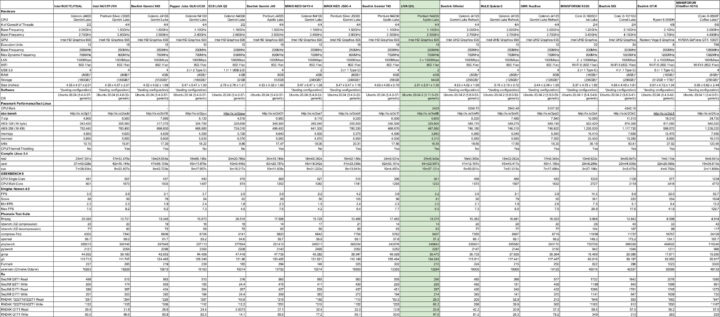
之后,我又将它与使用较旧版N4200 CPU的其他迷你 PC进行比较,结果也是一致的。
在浏览器和 Kodi 中播放视频
对于实际测试,我在 Windows 上的 Edge、Chrome 和 Kodi 以及 Ubuntu 上的 Firefox、Chrome 和 Kodi 中尝试播放了一些视频。下表我总结了每个测试的结果:

请注意,虽然 ECS 在他们的营销中声称“最佳 4K 视觉体验”,但他们还声明操作系统支持“建议安装 Windows”,这可能是因为尽管 4K 在 Windows 中是可能的,但在 Ubuntu 中可能无法实现。
游戏
从上面的 Unigine Heaven 得分中我们可以看出,Q1L 提供的游戏性能是非常有限的。
Windows 与 Ubuntu
虽然这两个操作系统之间的详细比较超出了我本次评测的范围,但值得注意的是我有一些关键性的发现。然后,我去查看了一下两个操作系统之间常见的性能工具,结果证明它们性能是相当的。
我还发现,在 Ubuntu 中视频播放会变得很差。这是因为 CPU 上的高负载而发生了热节流,但风扇没有完全加速。所以,一旦风扇增速,热节流会减少,视频播放也就会得到改善。
LIVA Q1L 散热片
Q1L 有一个很静音的风扇,所以使用主动冷却时声音很小。运行时,在设备旁边使用声级计测量发现,声音分贝不超过 38 dBA。
在 Ubuntu 上运行压力测试时,我发现 CPU 的温度迅速上升到了 89°C,然后又下降到 77°C。接着,在 15.3°C 的环境室温下又缓慢攀升至最高温度 95°C。

一旦测试完成,温度就下降了:

联网
在 Ubuntu 上使用“iperf”测量网络连接吞吐量:

在LIVA Q1L 上安装 pfSense
由于 Q1L 包含双千兆以太网端口,并满足pfSense的最低硬件要求(它是 FreeBSD 的免费、开源定制发行版,专门用作防火墙和路由器,完全通过 Web 界面进行管理)。所以,我就尝试安装并配置了 pfSense 用来控制Ubuntu中LiveUSB的web访问,并将ubuntu系统安装在了一台直接连接英特尔的NUC中。

这样做之后,我发现尽管安装相对来说很简单,但运行可能会超时(可能由 SD 卡插槽的已知问题引起)从而减慢了启动过程。

但是,pfSense 在 Q1L 上却运行良好,如下如所示:

而且也可以直接从 NUC 上访问。

安装完 squidGuard 软件包后,我就成功地阻止了对特定网站的访问。这里我用的是cnx software网站举例。

接着,我又从 NUC 访问,依旧显示访问失败。

这当然不是推荐的常规配置!
适用于 LIVA Q1L 的 Windows 10 驱动程序
在 ECS 网站上,有Windows 驱动程序的下载链接。不过本次评测暂时不做。我做了一些其他的测试。
功耗
功耗测量如下:
- 断电(关机) – 0.5 瓦 (Windows) 和 0.2 瓦 (Ubuntu)
- BIOS* – 5.0 瓦
- GRUB 启动菜单 – 4.9 瓦
- 空闲 – 5.0 瓦 (Windows) 和 4.4 瓦 (Ubuntu)
- CPU 压力 – 9.9 瓦(Windows ‘cinebench’)和 11.0 瓦(Ubuntu ‘stress’)
- 视频播放** – 7.5 瓦 (Windows Edge 4K30fps) 和 11.1 瓦 (Ubuntu Chrome 1440p30fps)
*BIOS(见下文)
**功率数字在运行时会波动,因此该值是中值高功率读数和中值低功率读数的平均值。
BIOS
启动 Q1L 后,按 F7 键会出现一个引导菜单,其中包括了对 BIOS 的访问。可以看到 BIOS 还是非常有限的。
相关视频链接,点击此处即可查看。
写在最后
有时,由于端口遗漏,迷你 PC 会因为变得太小而无法正常工作。其实虽然没有耳机插孔,但 Q1L 的端口布局足够宽敞了,所以通过提供通常所需的最少数量和类型的端口来实现无干扰连接和功能是足够的。
| 强调: | 限制: |
|---|---|
| 小尺寸 | Ubuntu 4K 播放 |
| 双千兆以太网 | 受限 BIOS |
最后,十分感谢 LIVA 提供 Q1L 给我评测。目前,LIVA Q1L测试使用的配置零售价大约是 299 美元,其中包含了获得许可的 Windows 10 专业版。

文章翻译者:Nicholas,技术支持工程师、瑞科慧联(RAK)高级工程师,深耕嵌入式开发技术、物联网行业多年,拥有丰富的行业经验和新颖独到的眼光!



